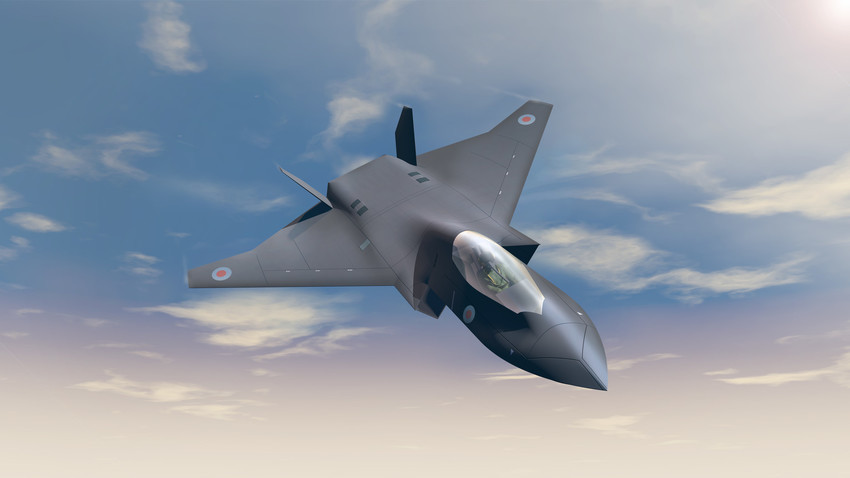 FARNBOROUGH AIRSHOW: Senior representatives from the Italian Ministry of Defence and Leonardo have disclosed new details about the workshare they are developing for the UK-led Future Combat Air System (FCAS), including details of Japan’s collaboration on sensor and communication capabilities.
FARNBOROUGH AIRSHOW: Senior representatives from the Italian Ministry of Defence and Leonardo have disclosed new details about the workshare they are developing for the UK-led Future Combat Air System (FCAS), including details of Japan’s collaboration on sensor and communication capabilities.
Speaking to the media Tuesday at the Farnborough Airshow, Lt. Col. Davide Dentamaro of the Italian National Armaments Directorate’s FCAS Program Office and Leonardo’s executive team confirmed they remain in the assessment phase at uni- and multi-lateral levels.
“We are in discussions with government counterparts to assess any overlap of respective national requirements,” Dentamaro confirmed before adding: “This is an important phase to define the requirements.”
He also suggested the ongoing FCAS effort is “very different” than legacy efforts in European combat air, which often saw national industries battling one another into inefficiencies. In contrast, “There is complete synergy across industry [and government] partners,” he said.
FCAS is a multi-lateral program to design a sixth-generation combat air capability. Established in 2018 by the UK MoD, the program now includes Italy and most recently a team-up with Japan; Sweden is also closely observing the process, according to program officials this week.
However, Andrew Howard, the director of Major Air Programmes for Leonardo UK, said he expects to see differences in national requirements emerge over time.
“There will be commonality to drive efficiencies but there needs to be freedom of maneuver and freedom of action which can be accommodated through open architecture. It is not affordable for one country to bring this program to life on its own,” he said.
On July 18, the UK FCAS team — featuring the UK MoD, BAE Systems, Rolls-Royce, Leonardo UK and MBDA — announced the Tempest Combat Air Platform Demonstrator, a key part of the FCAS program, would fly within the next five years.
According to Howard, the next two years will drive alignment in terms of national requirements, giving the tri-lateral FCAS team a 10-year period to deliver capability.
Meanwhile, Leonardo’s FCAS Director, Guglielmo Maviglia, confirmed Italy, the UK and Japan would benefit from the “new defense asset” in 2035 and beyond but also said the consortium would aim to “leverage” the export market as soon as 2040.
RELATED: Tempest Fighter To Wield Flying ‘Excalibur’ Lab For Digital Dominance
Maviglia also described how tactical and operational experiences generated by Italian and UK fifth-generation F-35s would matter for the development of a sixth-generation combat air platform.
“The leap from a 4G [Typhoon] to 6G [combat aircraft could be a real challenge,” he warned.
Maviglia also described how Japan has fit “seamlessly into discussions” so far, sharing similar ambitions for the program in terms of timelines.
“The Japanese requirement is similar to that of Italy and the UK. Early talks are very encouraging,” Howard added before describing how Leonardo in the UK and Italy is focused on developing FCAS’s Integrated Sensing and Non-Kinetic Effects (ISANKE) and Integrated Communications System (ICS) with industry partners including ELT.
“We are working together on a number of projects with Elettronica in Italy including joint assessment of potential architecture of a common ISANKE and ICS. The work is complementary to ongoing collaboration with Japan on 6th-generation sensor capabilities, an area in which Italy will soon be involved,” he said.
According to Leonardo, ISANKE is a “spider’s web” of capability that sits across the FCAS airframe.
“SANKE is a fully integrated network of multi-functional radio frequency and electro-optic sensing and non-kinetic effects nodes. Collectively, these nodes gather information from across the electromagnetic spectrum, which is then combined using sophisticated fusion algorithms. The result is a comprehensive situational awareness picture, which provides the aircrew with an enhanced view of the battlespace and real information advantage in combat,” a Leonardo spokesperson said after the event.
The ICS features multiple tactical communications and secure datalink systems which enable information to be exchanged rapidly across an FCAS formation to harness ISANKE fusion capabilities.
“ICS also enables FCAS to share information with the wider force mix, contributing information advantage in multi-domain operations. This is a key component of FCAS’s sixth-generation capability. The pilot will be more aware of their surroundings and other entities in the battlespace, more quickly and at longer ranges than ever before. This will result in superior combat effectiveness and survivability,” the spokesperson added.
Integration may end up the most important element of ISANKE and ICS, and so Howard also described how Leonardo remains in the process of creating a digital backbone for FCAS. A combat cloud is also scheduled to be delivered.
‘We are looking at specific areas for deeper collaboration,” Howard said. “For example, ICS is an important area for Italian expertise and multi-function processing must be collaborative moving forward on the back of a UK MoD Technology Demonstrator Program.”
Howard also highlighted UK and Japan’s Letter of Arrangement, signed in February, to conduct cooperative research in fighter jet sensor technology.
The “Jaguar” effort will feature the development of universal frequency sensor technology to allow aircraft to “better detect future threats from air, land and sea, quickly and accurately locating targets and denying surveillance technology operated by our adversaries,” according to a Leonardo statement at the time. (Japan’s expected role in the FCAS effort has since expanded.)
Leonardo sources suggested work could include the miniaturization of future radars, something which the company is pursuing at a “deeper level”, company executives concluded.






















